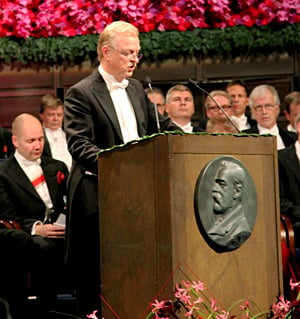Award ceremony speech
English
Presentation Speech by Professor Jan-Erling Bäckvall, Member of the Royal Swedish Academy of Sciences; Member of the Nobel Committee for Chemistry, 10 December 2010
 |
| Professor Jan-Erling Bäckvall delivering the Presentation Speech for the 2010 Nobel Prize in Chemistry at the Stockholm Concert Hall. Copyright © The Nobel Foundation 2010 Photo: AnnaLisa B. Andersson |
Your Majesties, Your Royal Highnesses, Ladies and Gentlemen,
This year’s Nobel Laureates in Chemistry are rewarded for a method to link carbon atoms together, and this method has provided chemists with an efficient tool to create new organic molecules. The Laureates have utilised the metal palladium to couple two carbons to one another under mild conditions and with high precision.
Organic molecules contain the element carbon, where carbon atoms are bound to each other to form long chains and rings. Carbon-carbon bonds are a prerequisite for all life on earth and they are found in proteins, carbohydrates and fats. Plants and animals mainly consist of organic molecules in which carbon atoms bind to each other, and we human beings, we who have gathered here today, are to a large extent built up by carbon-carbon bonds. In living organisms bonds between carbon atoms are created via Nature’s own pathways utilising various enzyme systems.
To create new organic molecules in an artificial manner that can be used as medicines, plastics, and various other materials, we need new efficient methods for synthesising carbon-carbon bonds in our laboratories.
Looking back in history we find that the German chemist Kolbe synthesised the first carbon-carbon bond in 1845. Since then a number of methods for the synthesis of bonds between carbon atoms have been developed of which several have been awarded with a Nobel Prize. This year’s Nobel Prize in Chemistry is the fifth that rewards the synthesis of carbon-carbon bonds.
Richard Heck’s pioneering work from 1968 – 1972 laid the foundation for palladium-catalysed formation of carbon-carbon bonds. He coupled two rather unreactive molecules to one another with the aid of palladium. One of these is a molecule with a handle, e.g. bromobenzene and the other has a double bond and is called an olefin. In 1977, Ei-ichi Negishi reported a mild method to couple one of Heck’s unreactive molecules to a carbon bound to zinc with the aid of palladium. Two years later, in 1979, Akira Suzuki found that the corresponding palladium-catalysed coupling of an unreactive molecule such as bromobenzene to a carbon bound to boron could be made under very mild conditions.
Carbon is stable and carbon atoms do not easily react with one another. Earlier methods used by chemists to bind carbon atoms together were therefore based upon various techniques for rendering carbon more reactive. Such methods worked when creating simple molecules, but when synthesising more complex molecules chemists ended up with too many unwanted by-products in their test tubes. The palladium-catalysed cross coupling solved that problem and provided chemists with a more precise and efficient tool to work with. In the Heck reaction, Negishi reaction, and Suzuki reaction, the carbon atoms meet on a palladium atom. When the carbon atoms meet on a palladium atom, chemists do not need to activate the carbon atom to the same extent. This entails fewer by-products and a more efficient reaction.
The palladium-catalysed cross couplings have been used for large-scale industrial manufacturing of, for example, pharmaceuticals, agricultural chemicals, and organic compounds that are used by the electronic industry.
Professors Heck, Negishi and Suzuki:
You are being awarded the Nobel Prize in Chemistry for palladium-catalysed cross couplings in organic synthesis and with these achievements you have provided organic chemists with efficient and useful methods for synthesizing compounds that were previously difficult to obtain. On behalf of the Royal Swedish Academy of Sciences, I wish to convey to you our warmest congratulations and I now ask you to step forward to receive your Nobel Prizes from the hands of His Majesty the King.
Nobel Prizes and laureates
Six prizes were awarded for achievements that have conferred the greatest benefit to humankind. The 14 laureates' work and discoveries range from quantum tunnelling to promoting democratic rights.
See them all presented here.
